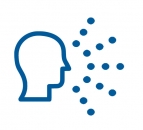Section 2: How is it Transmitted?


How is it Transmitted?
The virus mainly spreads when an infected person coughs, sneezes, or exhales near other people. Many people may not know they are infected because they may be pre-symptomatic or asymptomatic, but in either case, they may be contagious and can spread the virus to others.
A study in Proceedings of the National Academy of Sciences (PNAS) suggests at least 50% of COVID-19 infections come from people with no symptoms of the disease.
The World Health Organization (WHO) and more than 200 scientists acknowledge that COVID-19 may be airborne. This means smaller viral particles can hang in the air for hours and spread more easily than previously thought, particularly in indoor environments. The CDC has also updated its guidelines to reflect a longer trajectory of airborne transmission in indoor environments. Whenever possible, maintain a distance greater than 6 feet from others when indoors.
In December 2020, a new, more contagious variant of COVID-19 was discovered in the U.K. and has spread to a number of countries including the United States. Since then, new variants have emerged around the world. The new variants appear to be 50%-70% more transmissible and possibly more dangerous, though these estimates could change as more data is collected. So far, FDA-approved vaccines are believed to be effective against the new variants. Viruses mutate constantly, which is why a new flu vaccine is needed every year. Pharmaceutical companies are working on vaccine boosters to continue to fend off the virus and its variants.
As pharmaceutical companies work to stay ahead of emerging variants, researchers are exploring how to develop a universal vaccine that protects against all COVID-19 mutations.
The best way to prevent COVID-19 is to get vaccinated. By doing so, you are much less likely to become infected. However, if you do become infected, the risk of developing severe illness is greatly reduced. The risk of transmitting COVID-19 if vaccinated is still not clear, but most experts believe the risk is less likely. A Harvard study suggests that if vaccinated and testing positive for COVID-19, transmission is possible, but for a shorter period of time.
Contact Proximity and Time
The CDC defines close contact for COVID-19 as being within 6 feet of distance from anyone who could potentially be infected, for a cumulative total of 15 minutes or more over a 24-hour period. However, the CDC notes that defining “close contact” is difficult, and note that in general, closer proximity and/or a longer duration of time, as well as severity of symptoms (if the infected person is sneezing or coughing), and insufficient ventilation, all increase one’s risk of exposure. These measures (6 feet and 15 minutes over 24 hours) may be used as an operational definition for contact investigation when tracing exposure and advising when one should quarantine.
See common and serious COVID-19 symptoms.
You can also catch the virus by touching surfaces that have been contaminated and then touching your face. Wash your hands for 20 seconds with soap and water after you have touched anything that could be contaminated. If soap and water are not available, use a hand sanitizer with at least 60% alcohol.

Face Masks
Along with all other safety guidelines, the Centers for Disease Control and Prevention (CDC) recommends wearing face masks in public areas. The CDC reports that wearing a properly fitted, multi-layered cloth face mask helps protect others from becoming infected and also helps protect the wearer from infection.
Health agencies are now urging the use of double masks. The CDC has updated its mask guidance here. Recommended: Disposable mask underneath and a cloth mask on top.
A study tested the effectiveness of common face masks used to help prevent the spread of COVID-19. The study found the most effective masks were fitted N95, 3-layer surgical masks, and multi-layered cotton masks. Bandanas were found not to be very effective, and neck fleeces (gaiters) actually helped the spread of particles and were therefore considered even less effective than wearing no mask at all.
Not only have 3-layer face masks been shown to reduce transmission and slow the spread of COVID-19, early reports in the New England Journal of Medicine suggest that proper use of effective face masks could also reduce the severity of disease and help promote immunity.
Make sure the mask fits snugly over your nose. A good mask should have a nose wire that allows it to fit comfortably snug and stay in place over your nose. Studies have shown that your nose is one of the main ways the virus enters your body and makes you sick. It is essential that your face mask covers both your mouth and nose with no gaps to help protect against infection.
The World Health Organization (WHO) offers a short video tutorial on how to safely wear a mask.
Wash and dry masks regularly. Do not touch the exterior of the mask and then touch your face.
A fitted N95 mask is the gold standard of face masks. One expert even touted it as the mask that “would stop the epidemic.” However, N95s are costly, in short supply, and are not reusable. Researchers at MIT and Brigham and Women’s Hospital have designed an N95 mask where everything but the filters are reusable. The next step to making these reusable N95’s available to the public is testing and scaling.
It is important to remember that face masks can help protect you from infection provided you also practice social distancing.
Face Shields
A clear face shield offers some protection from larger droplets but does not offer the same protection from airborne droplets. If you want to use a face shield, do so in addition to wearing a 3-layer fitted face mask for the best protection.
Eye Protection
Research also shows that eye protection, such as goggles and possibly even eyeglasses, may reduce transmission.
Ventilation
One preprint study reported you are 19 times more likely to contract COVID-19 indoors than outdoors. One reason for this is that indoor spaces have less ventilation. Personal protective equipment (PPE), such as facemasks, goggles, and gloves, is especially necessary in indoor environments.
Indoors, the virus can remain airborne for up to 3 hours. Whenever possible, avoid spending prolonged periods in indoor, public environments. Always try to maintain a distance of at least 6 feet and wear PPE indoors. When indoors, experts recommend opening windows to increase ventilation.
Practice a Combination of Safety Measures
The WHO warns that wearing a mask could give you a false sense of security. It is vital you continue to practice social distancing, washing hands, and all other essential guidelines while wearing a mask. It is also important not to adjust your mask in a way that could lead to your hands touching your face as this could introduce contamination.
A video made by Japanese scientists demonstrates how microdroplets transmit the virus.

